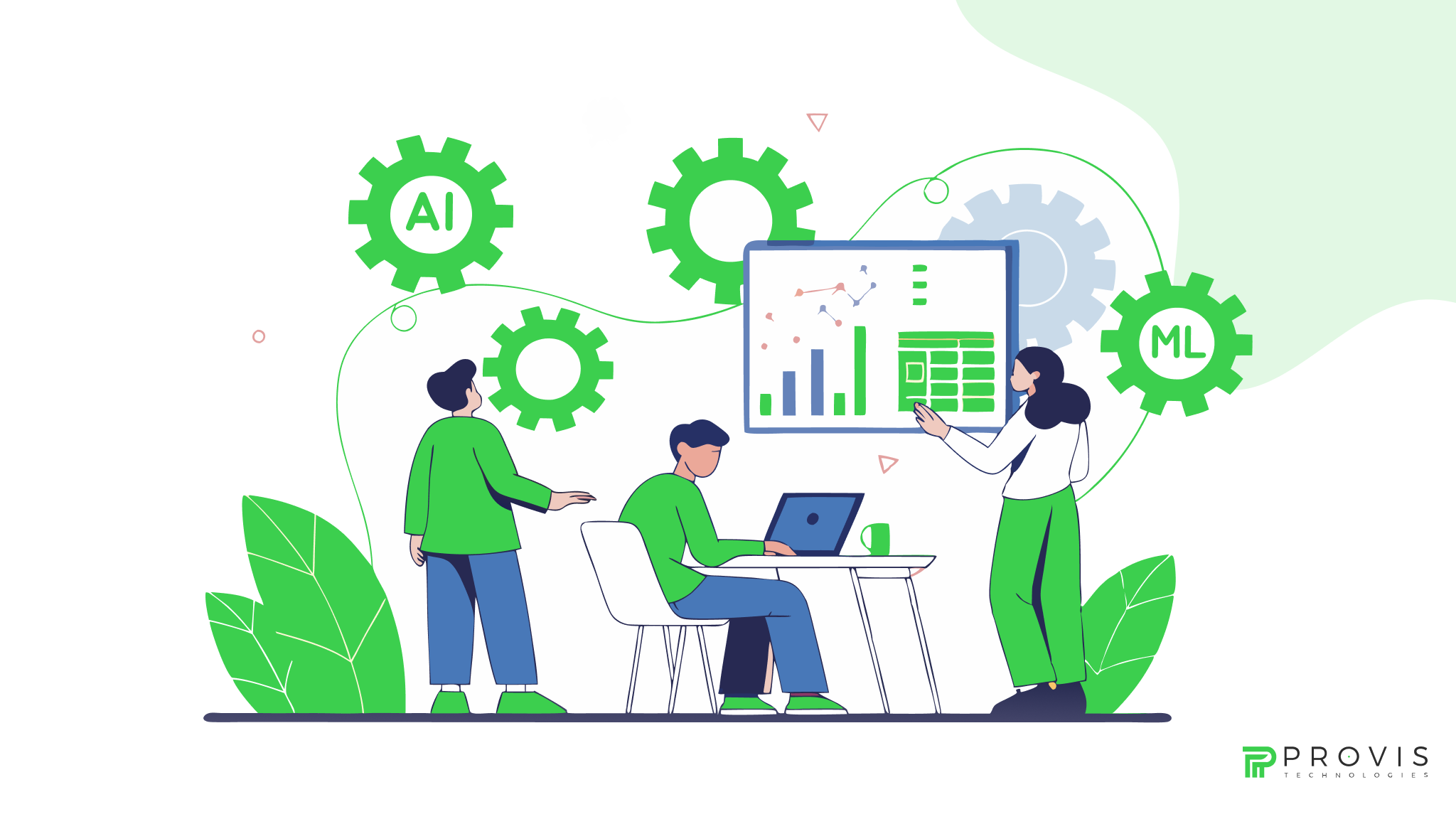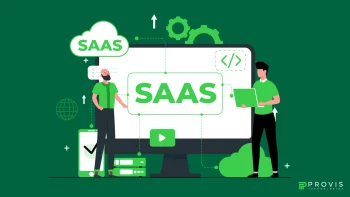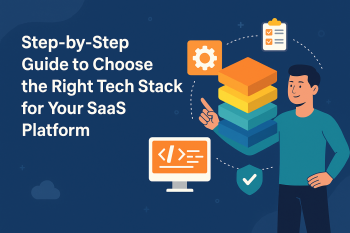Artificial intelligence (AI) and machine learning (ML) are disrupting the SaaS (Software as a Service) industry in fast-changing ways. These technologies are no longer just innovation trends but are actually transforming product development, optimization, and delivery in SaaS products. In the existing SaaS companies, AI and ML can be leveraged in the form of a great deal of intelligent, personalized, and efficient solutions. As a result, they enhance customer satisfaction, operational efficiency, and, in general, business growth.
This blog from Provis Technologies takes you through the different ways AI and ML are changing SaaS product development.
AI-Driven Insights to Personalize User Experience
AI in SaaS product development allow SaaS platforms to provide individualized experiences that are aligned with the behavior and preferences of each user. AI-driven recommendation engines and neural networks use the same by analyzing vast amounts of user data in order to predict which features or anchors will be most likely to engage with.
Moreover, AI in customer relationship management (CRM) tools is able to uncover customer needs and make suggestions for relevant interactions. Both intelligent chatbots and virtual assistants add another layer of refinement to the user experience by offering real-time support. Moreover, Natural Language Processing helps automatically respond with pre-defined answers and learn from customer interactions to give more accurate service.
A bonus of such personalization is that it makes the customer happy and retains the user. Thus, customers will return to the SaaS platform after some time.
Reducing Operational Costs and Automation of Workflows
Operations in the SaaS industry are being automated with AI in SaaS product development. With minimal human intervention, tasks like data entry, document processing, and lead scoring can now be managed.
These repetitive processes mean that human error is significantly reduced, and efficiency is increased. Also, businesses can spend more of their time growing strategically rather than doing routine administrative tasks with SaaS development with AI.
AI-driven workflow automation tools take in the existing business processes, find the inadequacies, and optimize them to increase productivity.
Marketing automation software based on AI can segment the audience, schedule campaigns, and crunch the engagement metrics, all working automatically.
It is another key advantage in terms of reducing operational costs. This allows companies to be more efficient and less expensive by automating labor-intensive tasks with AI in SaaS product development rather than allowing tasks to continue to be labor-intensive.
Strengthening Security and Fraud Prevention
With an increasing number of cybersecurity incidents, SaaS security cannot exist without AI and ML. These technologies monitor the activity of users and identify anomalies, which can be a sign of cyber threats.
Security systems powered by AI analyze huge amounts of data to spot the patterns that could take place during unauthorized access attempts, phishing attacks, and payment fraud attempts.
With the help of predictive analytics, SaaS companies will be able to predict and proactively address these vulnerabilities before they are exploited.
Furthermore, authentications use best-in-class AI mechanics, such as biometric verification and behavioral analysis. This improves security by ensuring that legitimate users only gain access to sensitive data.
Better Decision Making through Enhanced Data Analytics
Today, AI in SaaS product development is helping SaaS companies to a very good extent in analyzing and understanding the data. While traditional data analytics needs manual input and human interpretation, modern AI-driven analytics solves this problem automatically.
Structured and unstructured data are processed by machine learning in SaaS to understand trends, correlations, and potential business opportunities. Valuable accuracy and predictive analytics make that possible.
In addition, AI-assisted business intelligence tools enable decision-makers with insights to make real-time decisions. It is possible through informed decisions to improve competitiveness and revenue growth.
AI Software Development and Testing
The software development lifecycle is also going through a revolutionary change with the help of AI.
Programmers can use AI tools that help them with suggested code optimizations, detect inefficiencies, and automate debugging processes.
AI-fueled automated testing helps speed up the software application testing time before it is deployed.
AI- drivern SaaS testing tools driven by AI in SaaS product development simulate how exactly users interact with an application, find potential bugs to break, and make sure it functions seamlessly across different environments. It enables faster cycles, decreases errors, and increases the software quality.
Predictive Maintenance and Performance Optimization
In order to keep SaaS applications running at the top of the line, they have to be maintained constantly. The use case of using AI in SaaS product development tools for predictive maintenance includes analyzing system logs, user interfaces, and performance metrics. This helps anticipate future defects before they are formed.
AI helps IT teams proactively come up with preemptive actions, such as identifying bottlenecks, server downtimes, or software glitches beforehand. As a result, it reduces downtimes and allows a smooth user experience. To this effect, it provides extra strength to an application and reduces the costs related to system failure.
Moreover, AI in healthcare is also becoming popular due to the emergence of predictive analysis.
AI-Powered Customer Support and Sentiment Analysis
Modern SaaS has customer support evolving with the help of AI-powered virtual assistants and sentiment analysis. AI chatbots deliver instant responses, reducing wait times and increasing user satisfaction.
Whereas traditional customer service involves human agents responding to a customer’s questions, AI-powered bots respond all the time. Therefore, they answer many queries at a time, which allows human agents to focus on complex issues.
AI helps sentiment analysis tools like finding the pain points in customers’ emails, chats, and reviews to understand what they’re concerned about. This facilitates SaaS businesses to hone their products and services around real customer insights, thereby driving up customer relationships and customer loyalty.
The Future of AI and ML in SaaS Development
Since AI in SaaS product development continues to be advanced, you can expect to see a much stronger impact on SaaS development.
- The increasing use of AI-based low-code and no-code platforms has helped businesses develop applications faster without relying on traditional coding talent.
- The creative role of AI in SaaS companies is going to be streamlined with the help of generative AI. It will be useful in content creation, marketing automation, and design.
- Hyper-automation (AI, ML, and robotic process automation) is also expected to accelerate business processes and optimize resource utilization.
- Down the line, the AI solutions on top of SaaS will become more autonomous, deep learning, self-optimizing, and self-healing.
- Those companies who adopt these improvements take advantage of better, more intelligent, scalable, and efficient solutions, creating a competitive advantage.
The Bottom Line
SaaS product development is being massively reshaped by AI and ML. Many forms of personalization, automation, security, and efficiency are becoming popular because of their presence.
By integrating AI-driven insight, SaaS companies can design better solutions across the board. This helps in making them smarter, enabling better user experience, streamlining operations, and accelerating business decisions.
As these technologies get better, the businesses that incorporate AI and ML will define how AI is changing SaaS.
In such an increasingly digital world, SaaS companies must take advantage of what these innovations bring in order to provide more dynamic, more responsive, and more intelligent software solutions.
Written By
Author's Picks
- 3 Key Factors in Selecting the Right AI Tools for Your Business
- 17/02/2025
- How to Improve Your Website With Artificial Intelligence?
- 02/09/2024
- AI In Automotive Industry 2025: Benefits, Applications & Future
- 23/12/2024
Categories
- AI for Startups
- AI in Web Development
- AI Integration
- AI Platforms
- AI Prompt
- AI Tools
- AI Trading Software
- Android App
- Android vs iOS Development
- Angular
- API
- API Development
- App
- app development
- App Idea
- App User Feedback
- Application
- Artificial Intelligence
- Audit Services
- Automotive Industry
- Awards and Recognition
- Business Consulting
- Business Website
- Chatbots
- CRM
- CRM for Financial Advisors
- Custom CRM
- Custom SaaS
- Custom Website
- Customer Service
- dashboard design
- Developing a Mobile App
- Digital Business
- E-commerce
- EMR Integration
- Finance
- Financial Advisors
- Financial Advisors
- GIT
- Health Insurance
- iOS App
- iOS App Development
- IoT Mobile App Development
- IoT Platforms
- IT Audit Services
- IT Consulting
- IT Strategies
- Java Development
- Laravel
- Lean Canvas
- Learning Management System
- Logistics Apps
- Mobile App Development
- MVP
- Native App
- News Aggregator Site
- OTT
- Outsourcing IT
- Payment Gateway
- predictive analysis
- Product Launch Strategy
- Progressive Web App (PWA)
- Prototype
- Recommender Systems
- Ruby
- SaaS
- SaaS Application
- SaaS Business
- SaaS Company
- SaaS Development
- SaaS Product
- SaaS Project
- Sales Funnel
- SEO
- Shopping Cart
- Software Development
- SSL and TLS
- Startup Checklist
- Technology
- Tetradic Color Scheme
- UI/UX Design Company
- Unit Testing
- User Flow
- User Testing
- Web Development
- Web Performance Optimization
- website Maintenance Services
- Website Migration Service
- Website Speed Optimization
- WooCommerce
- WordPress





